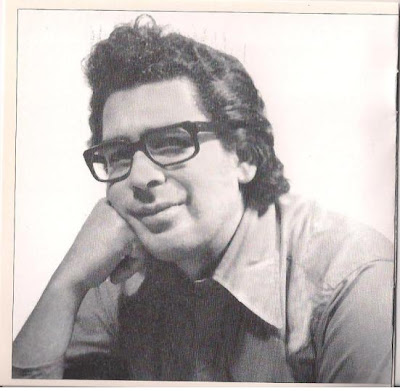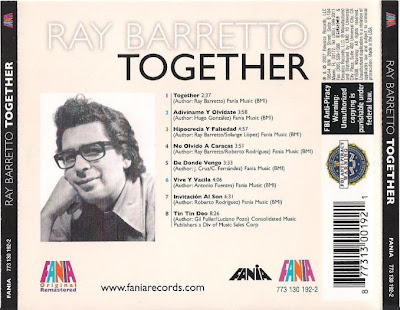RAY BARRETTO ''TOGETHER'' (USA,1969)
RAY BARRETTO
''TOGETHER''
(USA,1969)
Aproximadamente un año antes de que falleciera en 2006 a la edad de 76, el maestro conguero Ray Barretto me concedió una entrevista en conexión al lanzamiento de su último disco, una excelente sesión de jazz latino titulada Time Was - Time Is. Barretto era un conversador amable y perceptivo. Hablamos sobre su gloriosa carrera y el importante papel que jugó en la explosión salsera de los años '70 en Nueva York.
De repente, hubo un dejo de tristeza en la voz del maestro. No sé si se me dará la oportunidad de grabar otro disco, dijo con un suspiro. Me parece que se me terminaron los 15 minutos de fama.

Me quedé atónito. ¿15 minutos de fama? Recordé la prolífica discografía de Barretto, que incluye vibrantes discos de charanga y salsa, pachanga y boogaloo, acid-soul y jazz, hasta un tributo lounge a la música de las películas de James Bond. Pocos músicos, no importa cual sea su género, han trabajado en un contexto tan variado.
No quiero sonar como que me estoy lamentando, explicó Barretto. Sería un tonto si dijera que no he logrado algo-- creo que representé tanto a la salsa como al jazz latino con dignidad. Pero el tiempo pasa tan rápido... uno mira a su alrededor y piensa: '¿Dónde se fueron tantas vivencias?' Parece que todo hubiera durado 15 minutos.
En ese momento, me di cuenta de que hay algo en los discos de Barretto que contribuye a crear ese sentimiento de nostalgia: son tan intensos y emocionantes, que inevitablemente llegan a su fin demasiado pronto.
Lo mismo pasa con el disco que usted tiene ahora en sus manos. "Together" pertenece a la primera época de la Fania entre fines de los '60 y comienzos de los '70, el momento justo antes de que Barretto alcanzara su plenitud artística con importantes grabaciones como The Message e Indestructible. El disco cuenta con el plantel clásico de Barretto antes de que la mitad de su orquesta lo abandonara para formar la Típica 73: entre otros, están Orestes Vilató en los timbales, un jovencísimo Andy González en el bajo y el formidable talento vocal de Adalberto Santiago.
En ese entonces éramos como niños con juguetes nuevos, me contó Barretto cuando le pregunté sobre la inocencia de esas primeras grabaciones. A medida que pasa el tiempo, entra en juego la experiencia y uno busca propuestas más sofisticadas. Pero en esos días, el intelecto no era parte de la ecuación.

"Together" muestra la polifacética personalidad musical de Barretto, ofreciendo algunos contrastes fascinantes. El tema que le da el nombre al disco es puro soul afro-latino con un dejo de psicodelia. A éste le sigue el tradicional swing cubano de “Adivíname y Olvídate”. También están el sermon moral de “Hipocresía y Falsedad” (co-escrito por el mismo Barretto), la agradable melodía de la composición de Tito Puente “Vive y Vacila” y el momento más trascendental del disco: una versión sinuosa y mística de “Tin Tin Deo”, el tema de Chano Pozo que ha sido grabado por muchos grandes artistas, desde Machito hasta Eddie Palmieri.
Barretto reflexionó sobre la clave del éxito de discos como "Together".
Entendía el espíritu callejero y contrataba a buenos arreglistas, dijo. También me aseguré de que la interpretación de las canciones fuera tan poderosa como la belleza de éstas. Todos los elementos estaban en su lugar. Si los escuchas hoy, comprobarás que esos discos han sobrevivido el paso del tiempo.
Escrito por Ernesto Lechner
****************

About a year before he passed away in 2006 at age 76, I interviewed master conguero Ray Barretto in connection to the release of his last album, the excellent Latin jazz session Time Was - Time Is. In conversation, Barretto was affable and perceptive. We talked about his glorious career and his important role in the New York salsa explosion of the '70s.
Suddenly, there was a hint of sadness in the maestro's voice. I'm not sure if I will get to make another album again, he said with a sigh. I guess I've had my 15 minutes of fame.
I was shocked. 15 minutes of fame? I reminded Barretto of his prolific discography, which includes vibrant albums of charanga and salsa, pachanga and boogaloo, acid-soul and jazz, even a lounge tribute to James Bond movie music. Few musicians, regardless of genre, have had such a wide canvass of different rhythms and styles to work with.
I don't mean to sound like I'm crying the blues, Barretto explained. I would be a fool to say that I haven't achieved something-- I do believe that I've represented both salsa and Latin jazz with integrity. But time goes by so quickly... you look around and think: 'Where did it all go?' It seems like it lasted 15 minutes.
At that moment, I realized that there was an element about Barretto's albums that may have contributed to this feeling of fleeting nostalgia: they are all so soulful and fun and life affirming that, indeed, they go by way too quickly.

Consider the album you now hold in your hands: "Together" belongs to the early Fania period of the late '60s and early '70s, just before Barretto reached his creative peak with seminal salsa albums such as The Message and Indestructible. The record boasts the classic Barretto lineup before half of the conguero's orchestra defected to form the Típica 73: there's Orestes Vilató on timbales, a very young Andy González on bass and the formidable vocal talents of Adalberto Santiago.
We were like kids with new toys back then, just having fun, Barretto told me when I asked him about the wide eyed naiveté of his early albums. As time goes on, your experience comes into play and you strive for something more sophisticated. But in those days, the intellect was not part of the equation.
"Together" finds Barretto exploring various sides of his musical personality, which makes for some fascinating contrasts. The opening title track, a slightly psychedelic slice of Afro-Latin soul, segues seamlessly into the traditional, Cuban fueled swing of “Adivíname y Olvídate”. There's also the sobering moral sermon of “Hipocresía y Falsedad” (co-written by the maestro himself), the pleasantly melodic Tito Puente number “Vive y Vacila” and the record's most transcendental moment: a sinuous, simmering, near mystical version of “Tin Tin Deo”, the Chano Pozo composition that has been covered by everyone from Machito to Eddie Palmieri.
Barretto reflected on the sonic recipe that made albums such as "Together" so artistically successful.
I had a feeling for the street and was careful to hire good arrangers, he said. I also made sure that the interpretation of the tunes matched the beauty of the songs themselves. Every element came together. If you go back and check them out, you'll see that those albums stood the test of time.
Written by Ernesto Lechner
Credits:
Roberto Rodríguez – Trumpet
“Papy” Román – Trumpet
Orestes Vilató – Timbales
Tony Fuentes – Bongo
Louis Cruz – Piano
Andy González - Bass
Original Album Photography – Marty Topp
Original Album Design – Izzy Sanabria
http://ul.to/ggd3j6em




